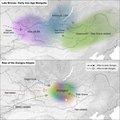Slika:Genetic history of Xiongnu.png

Velikost tega predogleda: 600 × 600 točk. Druge ločljivosti: 240 × 240 točk | 480 × 480 točk | 996 × 996 točk.
Izvorna datoteka (996 × 996 točk, velikost datoteke: 1,29 MB, MIME-vrsta: image/png)
Zgodovina datoteke
Kliknite datum in čas za ogled datoteke, ki je bila takrat naložena.
| Datum in čas | Sličica | Velikost | Uporabnik | Komentar | |
|---|---|---|---|---|---|
| trenutno | 03:39, 9. januar 2021 |  | 996 × 996 (1,29 MB) | Was a bee | {{Information |Description={{en1=The Eastern Eurasian Steppe was home to historic empires of nomadic pastoralists, including the Xiongnu and the Mongols. However, little is known about the region’s population history. Here, we reveal its dynamic genetic history by analyzing new genome-wide data for 214 ancient individuals spanning 6,000 years. We identify a pastoralist expansion into Mongolia ca. 3000 BCE, and by the Late Bronze Age, Mongolian populations were biogeographically structured int... |
Uporaba datoteke
Datoteka je del naslednje 1 strani slovenske Wikipedije (strani drugih projektov niso navedene):






